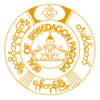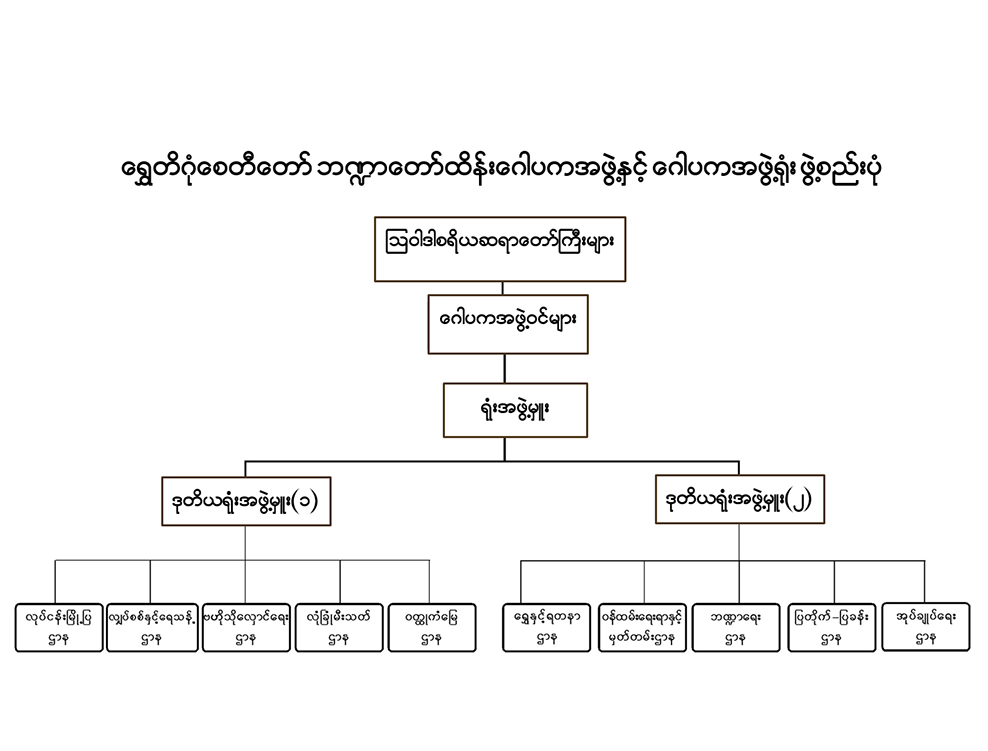Nowaday Maintenance
Great monks of the Ovadasariya



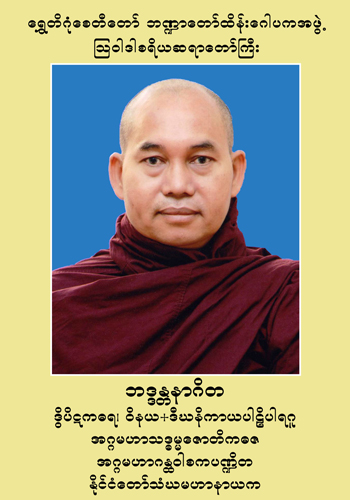
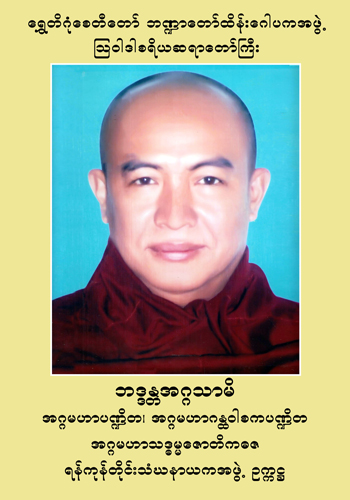

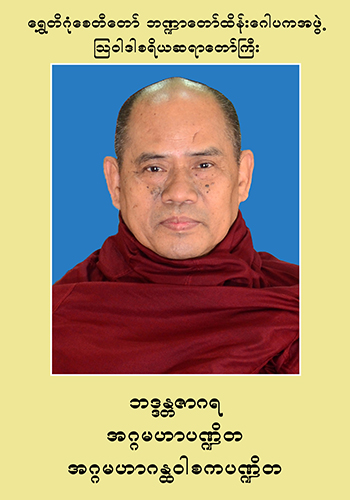
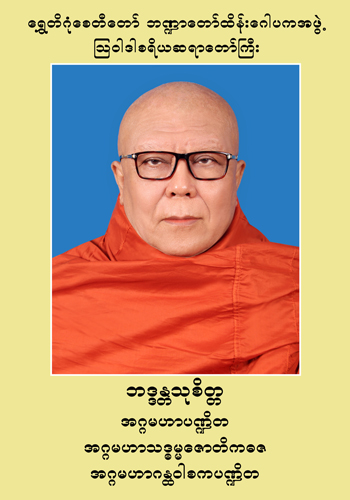
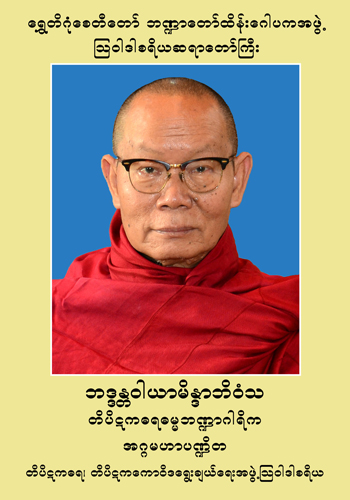


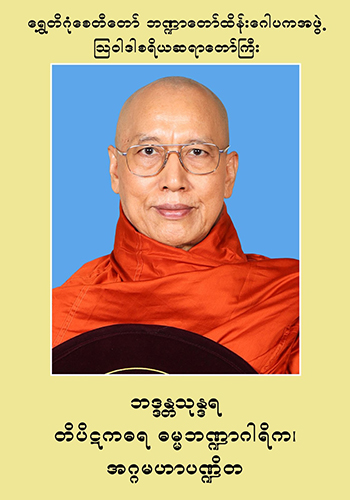
The Board of Trustees


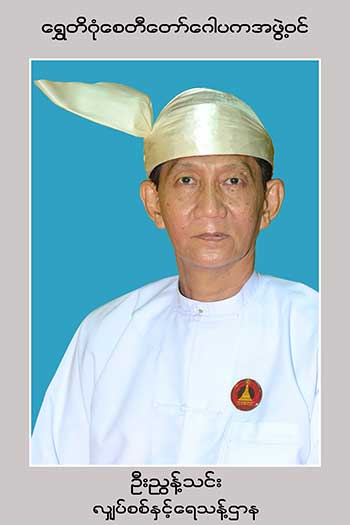

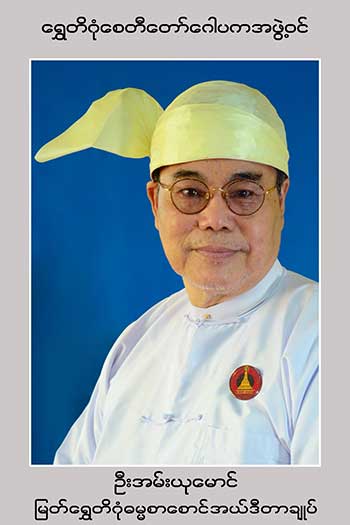
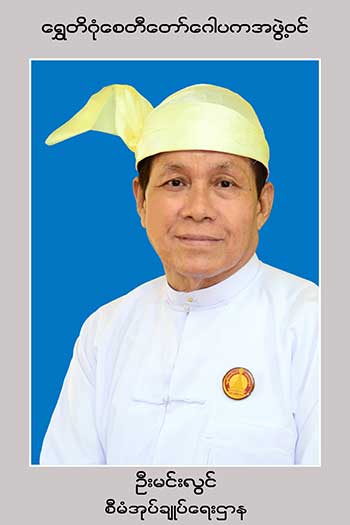
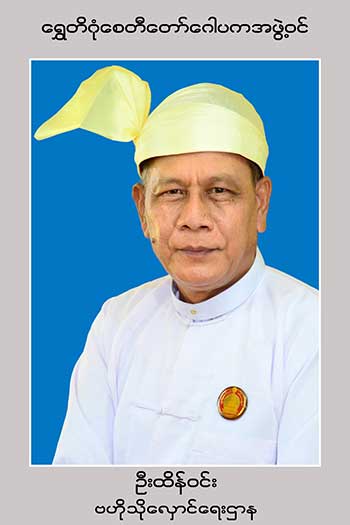


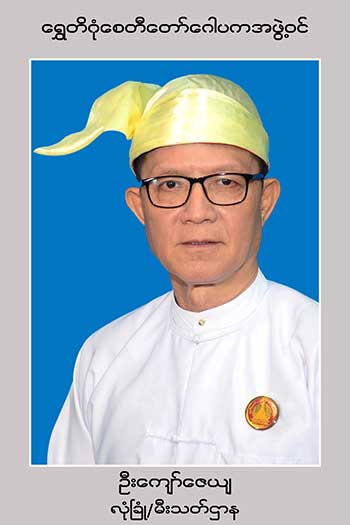


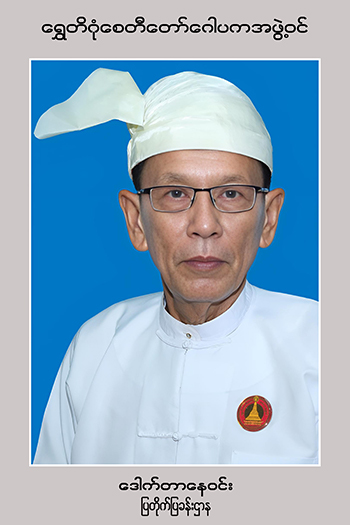
ဂေါပကအဖွဲ့ရုံးဌာနများ

ရွှေတိဂုံစေတီတော်ဘဏ္ဍာတော်ထိန်းဂေါပကအဖွဲ့ရုံး
ဌာန(၁၀)ဌာနရှိ ဖွဲ့စည်းပုံအင်အားအရ ခန့်ပြီးအင်အားစာရင်း
|
စဉ် |
ဌာန |
ဖွဲ့စည်းပုံ အမြဲတမ်း |
ခန့်ပြီးအင်အား | ယာယီနေ့စား | စုစုပေါင်း | ||||||
|---|---|---|---|---|---|---|---|---|---|---|---|
| အမြဲတမ်း | ပုံသေ | ရုံးနေ့စား | ကျွမ်းကျင် | ပညာရှင် | ပေါင်း | ခွင့်ပြု | ခန့်ပြီး | ||||
| ၁ | စီမံအုပ်ချုပ်ရေး | ၂၂၁ | ၁၃၁ | – | ၂ | ၅ | ၁၃၈ | ၂၂၄ | ၁၉၈ | ၃၃၆ | |
| ၂ | ပြတိုက်-ပြခန်း | ၁၁၃ | ၇၀ | ၃ | ၃ | ၁ | ၇၇ | ၇၈ | |||
| ၃ | ဗဟိုသိုလှောင်ရေး | ၆၇ | ၃၈ | ၆ | ၄၄ | ၂ | ၂ | ၄၆ | |||
| ၄ | ဘဏ္ဍာရေး | ၂၁၅ | ၁၆၈ | ၃ | ၁၇၁ | ၂၅ | ၂၅ | ၁၉၆ | |||
| ၅ | ဝန်ထမ်းရေးရာနှင့်မှတ်တမ်း | ၁၁၅ | ၆၆ | ၁ | ၆၇ | ၆၇ | |||||
| ၆ | ရွှေနှင့်ရတနာ | ၅၀ | ၃၂ | ၁ | ၃၂ | ၃၃ | |||||
| ၇ | လုပ်ငန်းမြို့ပြ | ၁၈၆ | ၆၀ | ၂ | ၁ | ၆၃ | ၉ | ၂ | ၆၅ | ||
| ၈ | လုံခြုံ-မီးသတ် | ၃၆၅ | ၂၅၂ | ၂၁ | ၂ | ၂၇၅ | ၁၈ | ၁၈ | ၂၉၃ | ||
| ၉ | ဝတ္ထုကံမြေသာယာရေး | ၉၀ | ၂၉ | ၂ | ၃၁ | ၉၀ | ၆၅ | ၉၆ | |||
| ၁၀ | လျှပ်စစ်နှင့်ရေသန့် | ၁၃၂ | ၆၄ | – | ၂ | ၆၆ | ၆ | ၄ | ၇၀ | ||
| စုစုပေါင်း | ၁၅၅၄ | ၉၀၇ | ၃၉ | ၂ | ၁၃ | ၁ | ၉၆၄ | ၃၇၄ | ၃၁၄ | ၁၂၈၀ | |
Board of Trustees Departmental duties

Structures and duties of The Department of Administration
( 2 ) Collecting fees and taxes of shops through four walkways and collecting electricity fees.
( 3 ) Collecting electricity bills and water taxes from the Rest Houses and Prayer Halls.
( 4 ) Conducting matters related to the supervision of religious associations.
( 5 ) Carrying out management and general affairs related to guardian monks.
( 6 ) Conducting administrative affairs of the Board of Trustees.
( 7 ) In events such as charity ceremonies, Ovada acceptance ceremonies, meetings, guest arrivals, and seasonal festivals, responsibilities related to event preparations and the tasks of the related organizing committee are carried out.
( 8 ) Responsibilities related to the cleaning of the Square, Planetary Posts, four walkways, and market halls, as well as overseeing cleanliness, are carried out. Wastes generated from the Square and the Horticulture ground are transported to designated waste disposal sites. From there, the wastes are taken by vehicles to the designated waste disposal zones specified by the city council for proper disposal.
( 9 ) Supervising and managing the daily regular operation of electric elevators and mechanical lifts to ensure their running smoothly.
( 10 ) Opening and maintaining inventory records, managing and overseeing related administrative matters, handling the management of vehicles for the Trustees office, purchasing and storing fuel for fire engines and other machinery, and distributing them as needed.
( 11 ) If visitors to the great stupa, who have come to pay homage and venerate the Buddha, unexpectedly suffer injuries or experience illness on the square, a free health clinic is opened to provide free medical care. Western and traditional medicine practitioners are available to treat and provide necessary treatment, and the purchase and replenishment of medicines and medical supplies are also managed.
( 12 ) In order to effectively carry out the duties of the great stupa within the staff residences located inside the Shwedagon Pagoda’s grounds, staff members from the Trustees office are assigned to the staff residences based on decisions made in the Trustees office meetings. A supervisory team of the staff members is established, and regulations regarding the staff residences are set and enforced.
( 13 ) Issuing access cards for visitors to the upper platform of the Shwedagon Pagoda and setting regulations.
( 14 ) Managing and supervising services provided to visitors at the Shwedagon Pagoda, including collecting fees from the east and south vehicle parking areas, managing the shoe keeping service, overseeing the (W.C) cleaning services, and purchasing and replenishing necessary supplies.
Structures and duties of The Department of Museum and Gallery
(2) Carrying out the maintenance and preservation of materials related to the museum, the Pitaka Library, and the Maha Buddhavavisa Exhibition Hall to ensure their long-term durability.
(3) Carrying out cleaning and inventory checks of the museum and exhibition materials displayed within the museum and exhibition halls in accordance with the museum’s regulations.
(4) Opening a donation office in accordance with regulations to facilitate the process for visitors who come to admire and study at the museum, Pitaka Museum, Maha Buddhavavisa Exhibition Hall, and the photography exhibition hall, making it easier for them to make donations.
(5) To preserve the books and documents related to Buddhism at the Pitaka library in accordance with the library’s regulations, using modern technology to ensure they are easily accessible for the public to read, and to maintain the donations of scriptures and texts offered by the public in a sustainable and durable manner. Also, to provide support with advanced systems to make them easier for researchers to access the materials they wish to read.
(6) Carrying out cleaning and environmental beautification activities inside and outside the buildings of the museum, exhibition halls, and Pitaka library department
(7) Preserving valuable items, Buddhist-related books and documents, and displayed antique artifacts inside the museum, exhibition halls, and Pitaka library using modern technologies to ensure their long-term sustainability. Ensuring proper security measures are in place to prevent damage, loss, or theft.
(8) The Board of Trustees organizes art exhibitions and photo galleries from time to time to allow the public to learn about and admire the Buddha’s teachings. These activities are carried out in accordance with the museum and exhibition hall regulations by the museum, exhibition, and Pitaka library department.
Responsibilities of The Central Storage Department
(1) Purchasing, storing, and distributing construction materials necessary for the regular maintenance and renovation of Buddhist heritage buildings as well as for separate construction projects.
(2) Purchasing, storing, and distributing electrical materials and water purification supplies necessary for continuous use at the Shwedagon Pagoda.
(3) Procurement of special materials that cannot be purchased domestically, in accordance with procedures and regulations, by ordering from abroad.
(4) Accepting religious items donated by the public to the Great Stupa (statues, thrones, shrines, Kanakdan umbrellas, robes, etc.; Staring and distributing item, Storage Issuance)
(5) Purchasing, storing, and distributing writing tools, donation receipts, office stationery, and office equipment.
(6) Receiving and storing reusable construction materials from various renovation and construction projects, and distributing them for reuse in the workplace, or selling them through a tender process.
(7) Receiving and storing items such as bat dung and broken wax, and selling them through a tender process.
Responsibilities of the Finance Department
2. The Finance Department shall use consumption issues within the framework of financial regulation with thrifiness and carefulness.
3. Those items which cannot be purchased locally can be purchased from abroad according to the rules and regulations.
4. Yangon Region Audit Team or Any Registered Audit Team or Department Audit Team must audit every cost account and stock lists, and must ratify the accounts.
5. Myanmar Economic Bank, Savings Bank Branch (1) opened by the State to accept donations of Myanmar Kyats in accordance with the financial regulations for the growth security of the Pagoda’s treasure, Savings Bank Branch (2) and Depositing Foreign Currency in Myanmar Foreign Commercial Banks, shall be deposited.
6. In Myanmar Commercial Bank Branch (4), the main account and Donor Accountant No. CT-0016600 and Management Accountant No. CA-038302 shall be deposited, and disbursed.
7. All kinds of payments: All deposits and withdrawals shall be done in the respective banks and branches.
8. Vertification of expenses, Expenditure being a budgeted business, Obtaining the permission of the relevant department, Approving of the Board of Trustees with the verification in charge of financial authorization, obtaining the financial authorization and Payment by check from the Treasury Department, – every activity can be done.
9. The financial year of Shwedagon Pagoda is from 1st January to 31st December.
10. Drafting the annual business plan and estimated revenue and expenses of the pagoda in one financial year.
11. Budget Estimate shall be drawn in November and approved in December.
12. Revised Estimated Account (RE) shall be drawn up in July and approved in August.
13. Drafting the fund transfer shall be drawn in October and verified it in November.
14. Charity income and expenditure: Account title: Donations are given under ten (10) account headings; the expenditure according to the heading (10) of the account shall be used.
From the income of the charity
| Charitable income | Expenditure |
| List of Golden Robes | List of Golden Robes |
| A forever list | A forever list |
| the floor, List if the Great Wall | the floor, List if the Great Wall |
| Lists of Pagoda Stupas, Walkways | Lists of Pagoda Stupas, Walkways |
| Lists of elevators and escalators | Lists of elevators and escalators |
| General chore list | General chore list |
| A list of the prosperity of the Sacred Site | A list of the prosperity of the Sacred Site |
| List of high holidays | List of high holidays |
| List of water satellites and hydrology | List of water satellites and hydrology |
(15) Management Income and Expenditure Account: Cash management revenues is specified under ten acc: heads: Expenses are also used by the Management Income Account Heading.
| Management revenue | Expenditures covered by management revenue |
| Shops tax revenue | Salaries and allowances |
| Contract business income | Prize money |
| Clean room revenue | Seniority bonus |
| Shoe deposit | Food, Costume and travel expenses |
| Auction proceeds | Food Funding for old ages |
| Light service revenue | Social security costs |
| Toll revenue,alms service revenue | Other income |
16. Storage and deposit of donations: the Donation-money from the Shwedagon Pagoda main special donation centers and those donations from Buddha Veyyāvacca Donation-boxes, those donations from foreign visitors for the day, shall be kept in the cash room of the board of trustees office temporarily. On the next day the whole of money shall be put into the Bank.
17. Giving the donation receipts to donors for donations of materials; submitting to the Central Storage Central along with a list of photo records.
18. The France Department shall examine input and output balances of the Central Storage.
19. Saving certificates and Fixed Deposit Certificates shall be brought and kept to increase the amount of donation; Earning interest by depositing charity money into the books of accounts and operating in accordance with financial regulations.
20. Drafting monthly accounts, and annual accounts and presenting them to the Board of Trustees.
Staff Affairs and Records Department
Matters concerning the Ovādācariya Sayadaws, issues related to members of the Trustee Board, staff affairs, event organization, guest reception, archival record keeping, and press releases.
Gold and Jewels Department
Business Urban Department:
Security and Fire Department
Department of Electricity and Water
Religious preservation

Maintenance and Preservation of Shwedagon Pagoda and Religious Buildings
To ensure the effective maintenance and preservation of the pagodas, stupas, and religious buildings, the Treasury Management Committee receives close guidance from a council of senior monks. This council consists of eleven selected senior monks officially approved by the Ministry of Religious Affairs and Culture. The following measures are in place to ensure the long-term stability and preservation of the Shwedagon Pagoda and its religious buildings:
1. Formation of a council of senior monks to guide to the Treasury Management Committee.
2. Establishment of the Treasury Management Committee, with responsibilities divided among different departments.
3. Collaboration with religious organizations and staff to carry out preservation and maintenance activities.
Financial management and preservation efforts by the Treasury Management Committee play a crucial role in ensuring the long-term stability and maintenance of the Shwedagon Pagoda and related religious buildings.
Financial Management and Safeguarding
At the Shwedagon Pagoda, there are two types of income: donations from the public and management-related revenue from activities organized for the convenience of visitors. Expenses for offerings such as gold-leaf donations, maintenance of religious buildings, electricity, and water are covered by the donations. Salaries for staff and expenses for hosting guests are covered by management-related revenues. All income is formally documented with receipts, and all expenses are issued with payment vouchers to ensure proper financial control and usage.
The financial year is defined from January 1 to December 31 and plans for the upcoming financial year are compiled into an operational plan. Based on this plan, a budget similar to government procedures or estimated revenue and expenditure report is prepared and approved to ensure the proper control and usage of treasury funds.
Management and Preservation Efforts
Organization of the Cetiyangana Examination
Throughout this period, to ensure the longevity of the Buddhist teachings, the committee annually organizes the examination, celebrates the achievement of successful candidates, and offers monthly alms and rice donations. These religious activities are funded by donations from devout supporters, ensuring the continued vitality and prosperity of the Buddhist community.
Historically, the enduring preservation and flourishing of the Buddhist teachings can be traced back to the first Buddhist council organized by King Ajatashatru and led by Venerable Mahakassapa Thera with 500 monks. This tradition of diligent preservation by the Buddhist clergy has continued to the present day.
The organization of such prestigious and disciplined examinations as the Cetiyangana Examination, aiming to cultivate prominent individuals in the Buddhist teachings, is possible due to the encouragement from the state, the supervision of senior monks, the dedication of the participating monks, and the support from the public.
, the Buddhist faith will continue to flourish and shine brightly for future generations.
Since the inception of the Cetiyangana Examination, up to the 104th session, it has produced notable monks, including 923 who earned the title “Abhivamsa,” 11 who earned the title “Vamsakara,” and 373 who earned the title “Ganavacaka.”
Additionally, the Shwedagon Pagoda Treasury Management Committee conferred the honorary title of “Cetiyangana Pavarasiri Maha Dhammaguru” to commemorate the 100th anniversary of the Cetiyangana Pariyatti Examination. This title was awarded to four highly revered monks who have earned respect and veneration in the religious community due to their exemplary qualities, including:
• Pariyattivisārada Guṇa: Courage in the teaching and dissemination of scriptures.
• Ganthakāraka Guṇa: Expertise in compiling and composing scriptures.
• Paṭipatti Niyatāsaya Guṇa: Consistent dedication to meditation practice.
• Sīrapabbajita Guṇa: Exemplary adherence to the monastic discipline.
• Saṅghagaru Saṅghapariṇāyaka Guṇa: Being highly respected by the monastic community.
The four venerable monks honored with this title were “Rector Sayardaw or Pamaukha Choke (Ashin Nandamālābhivamsa) Sayadaw,” “Kalaywa Sayadaw,” “Yaw Sayadaw,” and “Hla Yatanar Sayadaw.”
The Cetiyangana Examination is one of the traditional, systematic, and challenging examinations in Myanmar, conducted under the guidance and supervision of senior monks with full devotion. The success of these examinations has brought joy and pride, fostering the growth of both worldly and spiritual benefits. It is believed that the efforts and dedication of the successful monks will continue to contribute to the enduring brilliance and prosperity of the Buddha’s teachings.
Celebrations of the Shwedagon Pagoda Buddha Puja Festivals
The committee has organized 84 religious associations to handle the various religious and maintenance activities related to the Shwedagon Pagoda. Additionally, there are 924 salaried employees and 326 daily wage workers. The Shwedagon Pagoda hosts year-round Buddhist ceremonies in a fully meaningful religious context, thanks to the devoted contributions of over 84 religious associations with an average strength of more than 4,000 members each and a workforce of 1,250 personnel, totaling over 5,000 individuals ensures that the 12 annual Buddhist festivals are celebrated with full religious significance.
The 2500th Anniversary of the Shwedagon Pagoda
From 1268 ME to 1273 ME, ornamented motif of inverted lotus petals, ornamented motif of full-blown lotus petals and row of bosses were made as gilding the upper portions of the Pagoda with gold plates. On Sunday, the 2nd waning of Kason, ME (1911 AD), a grand ceremony was held to reveal the gold-plated sections.
Gold-plated Shwedagon Pagoda’s terrace and grounds are cordoned off with red curtains. The plan is that when the rope is pulled, the curtain will open smoothly, revealing the gold leaf-covered area. In accordance with the British colonial period, prominent British officials, including four prime ministers, the Chief Commissioner Sir Harcourt Butler, General officers, and other noble audiences, were present. Upon the request to unveil the gold-leafed surfaces, the first public reading was done by Sayadaw and the virtuous Mayor U Pho Kyin, delivering an official speech. The gold leaf sheets were restored and offered by the Pateno Lord, much to the people’s appreciation. Following this, the chief celebrant, Mayor U Pho Thar, mentioned that this was the 2500th anniversary of the Pagoda. During the Gold Leaf Opening Ceremony, U Pho Myint requested that it was the right time to unveil the gold leaves. After delivering the ceremonial blessing, six gun-salutes were fired to commemorate the occasion, and when the rope was pulled, the nine red-covered lotus petals brightly revealed the golden light. More gun salutes followed.
Afterward, a feast was held in honor of 100 monks, with U Pho Thar, U Pho Min, and U Nay Dun offering alms and hosting meals. Guests were also treated to meals. The treasurers, dressed in long white robes, then honored and presented the gold-layering artisan U Thit with nine gold bricks and a badge as a reward. This event was documented during the Treasurers’ Association meeting held on May 14, 1911.
Even during British colonial rule, the treasurers and notable figures led the public in making gold offerings and hosting ceremonies at the Shwedagon Pagoda. Despite being under foreign rule, the 2500th anniversary of the Shwedagon Pagoda was celebrated, albeit in a subdued and declining manner, marking the conclusion of a significant period.
Shwedagon Pagoda 2600th Anniversary Festival
Since it has been 2600 years the Four-fold photograph of the revered Shwedagon Pagoda (Laysu Dhart Pone Shwedagon Pagoda) was first built, a great festival to commemorate the 2600th anniversary of Shwedagon hwe Tigon Pagoda is being held in a grand manner led by the Union Minister of the Ministry of Religious Affairs and the Yangon Regional Government. By celebrating the 2,600th anniversary of Shwedagon Pagoda, we will be able to remember the age of the Great Shwedagon Pagoda, worship its great attributes, and remember the teachings of the Lord Buddha. On the eve of the festival, a commemorative logo design competition, photo contest, painting competition, essay competiton were held to provide knowledge about Shwedagon Pagoda, offering with skills. Since the 4th day after the full moon of Tabodwe in 1373 before the Shwedagon Pagoda Buddha Pujaniya festival (11.2.2012), the diamond bud, and vane which were previously offered at Shwedagon Pagoda and preserved in the museum, were paid special respect by the local people while visiting the following 10 Sandawkyo pagodas(hair-relic pagodas) in Kwanchangon township, Kawhmu township, Twante township, Botahtaung township in Yangon division.
|
Wandering-being-paid-respected Sandawkyo pagodas(hair-relic pagodas)
|
|||
| Pagoda title | The village where it is located | Township | Arrival date |
| Kyaik-de-kanaung | De-danaw | Kwanchangon | 11-2-2012 |
| Kyaik-an-khalon | In Ga Lone | Kwanchangon | 12-2-2012 |
| Sa Bagan | Sa Bagan | Kawhmu | 13-2-2012 |
| Kyaik-ta-yoe-nut | Tarote Kone | Kawhmu | 14-2-2012 |
| Kyaik-ta-go-tut | Ta Guu Chan | Kawhmu | 15-2-2012 |
| Kyaik Mon Hto | Let Khaik | Kawhmu | 16-2-2012 |
| Kyaik Kawhmu | Kawhmu | Kawhmu | 17-2-2012 |
| Hp La Gyi | Hpa Yar Gyi | Twante | 18-2-2012 |
| Kyaik Kay Sar | Kabin | Twante | 19-2-2012 |
|
Botahtaung (Kyaik-de-att) |
– | Seikkan | 20-2-2012 |
Publishing of Myat Shwedagon Dhamma Books

2008, April
2008, July
2008, November
2008, February
2009, July
2019, November
2011, May
2011, November
2013, August
2013, December
2013, March
2014, July
2014, November
2014, March
2015, August
2015, December
2016, June
2016, October
2016, December
2017, May
2017, October
2017, January
2018, June
2018, October
Myat Shwedagon Dhamma Book Volume (3)
2019, June
2019, October
2019, May
2020, July
2020, November
2020, May
Volume (3), No. (7)
2022, January
2020, June
2023, January
2023, April
2023, July
2023, October
Volume (4), No. (1)
2014, January

